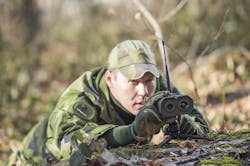Army researchers ask industry to develop unmanned and machine autonomy technologies for special forces
FORT DETRICK, Md. – U.S. Army researchers are asking industry to develop enabling technologies for battlefield situational awareness, reconnaissance and surveillance, and location technologies of potential benefit to special forces warfighters.
Officials of the Army Contracting Command at Fort Detrick, Md., issued a sources-sought notice last Friday (W911SR-22-S-NGIA) for the Next Generation Identification and Awareness Initiative (NGIA).
This is for companies interested in participating in projects sought by the United States Special Operations Command (USSOCOM) at MacDill Air Force Base, Fla., to develop state-of-the-art technologies in tagging, tracking, and locating; reconnaissance and surveillance; and unmanned systems. The NGIA seeks to develop special operations prototypes for demonstration and evaluation.
Tagging, tracking and locating involves ways to gain knowledge of when, where, and what the enemy is doing for mission planning in attacking high-value enemy warfighters and targets.
Related: Navy eyes large autonomous submarines for reconnaissance and special operations
Solutions should provide over-the-horizon and line-of-sight day and night target tracking for long periods using ground-based, airborne, or satellite sensors. Of special interest are low-probability-of-intercept and -detection communications, new ways of removing soldiers from the battlefield, and new ways to survive austere high-conflict environments.
Reconnaissance and surveillance involves new ways to gain intelligence in areas where the terrain, weather, political sensitivities, and hostile forces make intelligence gathering difficult. This will involve new kinds of unattended ground sensors with machine vision and object recognition to gather audio and video. These sensors should be able to evade enemy countermeasures.
Unmanned systems involve sensors on the ground and aboard small uncrewed aerial vehicles (UAVs) that weigh no more than 55 pounds. These sensors must be able to foil enemy attempts to eavesdrop on or jam their RF signals.
Related: Boeing to support large modular unmanned submarines
Machine autonomy capabilities on these small UAVs should help reduce operator workload, and help these UAVs evade enemy attempts to jam, capture, or destroy them.
Companies interested should email capabilities and questions no later than 1 April 2025 to the Army's David Shriner at [email protected].
For additional questions or concerns, contact the Army's Richard Totten by email at [email protected], or by phone at 301-619-2446. More information is online at https://sam.gov/opp/c069c6510a284e19907d3b409778155b/view.
About the Author
John Keller
Editor-in-Chief
John Keller is the Editor-in-Chief, Military & Aerospace Electronics Magazine--provides extensive coverage and analysis of enabling electronics and optoelectronic technologies in military, space and commercial aviation applications. John has been a member of the Military & Aerospace Electronics staff since 1989 and chief editor since 1995.
